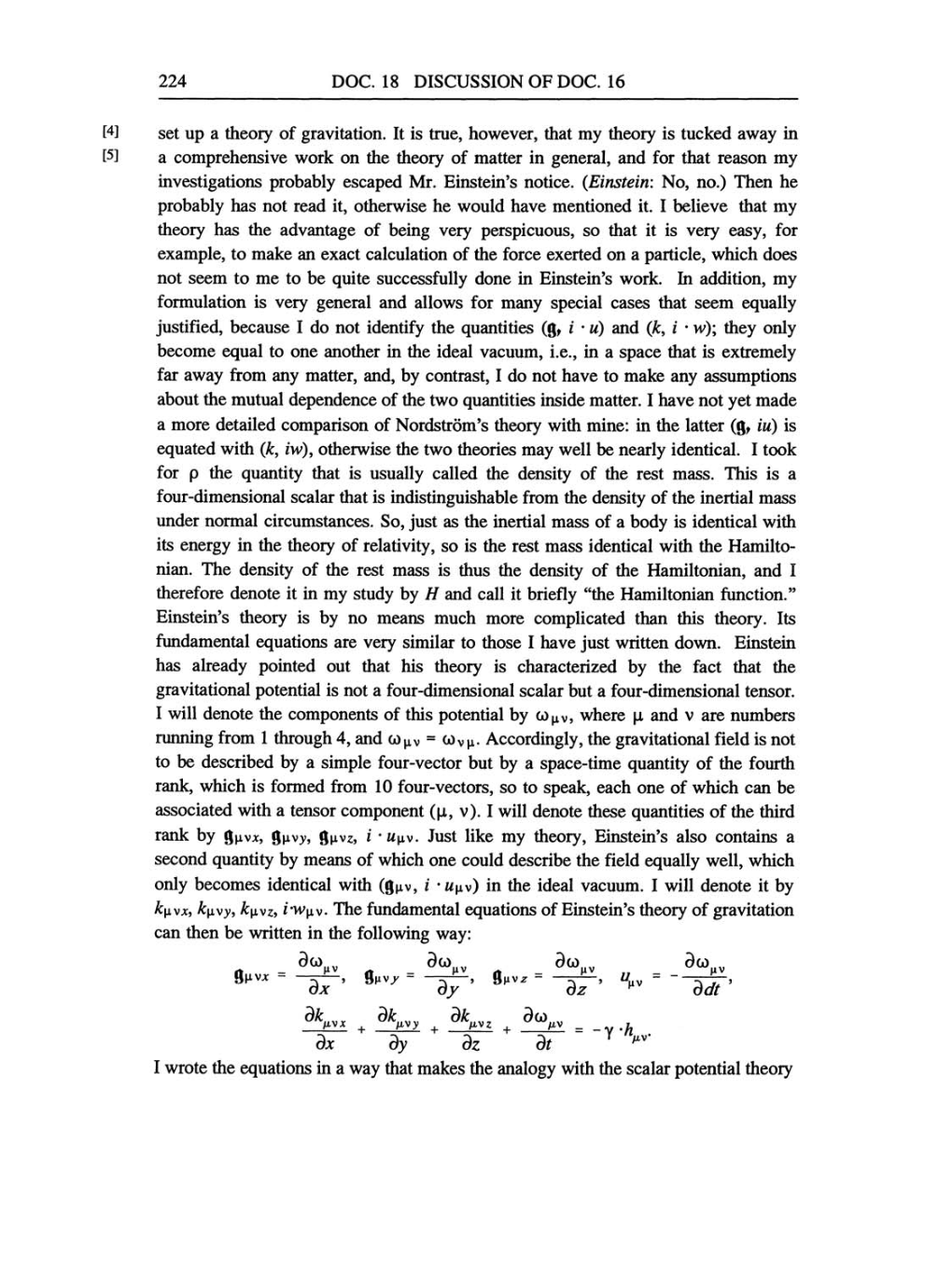224 DOC.
18
DISCUSSION OF
DOC. 16
set
up a theory
of
gravitation.
It is
true, however,
that
my theory
is tucked
away
in
a
comprehensive
work
on
the
theory
of
matter
in
general,
and for that
reason my
investigations probably escaped
Mr. Einstein's notice.
(Einstein: No, no.)
Then he
probably
has
not
read
it,
otherwise he would have mentioned
it. I
believe that
my
theory
has the
advantage
of
being very perspicuous, so
that it
is
very easy,
for
example,
to
make
an
exact
calculation of the force exerted
on a particle,
which does
not
seem
to
me
to
be
quite successfully
done in Einstein's work. In
addition,
my
formulation is
very general
and allows for
many special
cases
that
seem
equally
justified,
because I do
not
identify
the
quantities
(g,
i
•
u)
and
(k, i
•
w); they only
become
equal
to
one
another in the ideal
vacuum, i.e.,
in
a space
that is
extremely
far
away
from
any
matter, and,
by contrast, I
do not have
to
make
any assumptions
about the
mutual
dependence
of the
two
quantities
inside
matter. I
have
not
yet
made
a
more
detailed
comparison
of Nordström's
theory
with mine: in the latter
(g,
iu)
is
equated
with
(k, iw),
otherwise the
two
theories
may
well be
nearly
identical.
I
took
for
p
the
quantity
that is
usually
called the
density
of the
rest
mass.
This is
a
four-dimensional scalar that is
indistinguishable
from the
density
of the inertial
mass
under normal
circumstances.
So,
just
as
the inertial
mass
of
a
body
is
identical with
its
energy
in the
theory
of
relativity, so
is the
rest
mass
identical with the Hamilto-
nian. The
density
of the
rest
mass
is
thus the
density
of
the
Hamiltonian,
and I
therefore denote it in
my study by
H and call
it
briefly
"the Hamiltonian function."
Einstein's
theory
is
by
no means
much
more
complicated
than this
theory.
Its
fundamental
equations are very
similar
to
those
I
have
just
written down. Einstein
has
already
pointed
out
that his
theory
is
characterized
by
the fact that the
gravitational potential
is not
a
four-dimensional scalar but
a
four-dimensional
tensor.
I
will
denote the
components
of this
potential by
wuv,
where
U
and
v are
numbers
running
from
1
through 4,
and
wuv
=
wuv. Accordingly,
the
gravitational
field is
not
to
be described
by
a simple
four-vector
but
by
a
space-time quantity
of
the fourth
rank,
which is formed from
10
four-vectors,
so to
speak,
each
one
of which
can
be
associated with
a
tensor
component
(u, v). I
will denote these
quantities
of
the
third
rank
by
guvx, guvy, guvz,
i
•
Uuv.
Just like
my theory,
Einstein's also contains
a
second
quantity by
means
of
which
one
could describe the field
equally
well,
which
only
becomes identical
with
(guv, i
•
uuv)
in the ideal
vacuum.
I
will denote it
by
kuvx,
Kuvy, kuvZ,
i•wuv.
The fundamental
equations
of
Einstein's
theory
of
gravitation
can
then be written in the
following
way:
A
_
3t0|.v
A
Ä
9,1
v*= ~äT'
9"v'=
~äT'
9"v*=
~bF'
=
dk^x
+ + +
_
_vY
.h
dx
By
dz
dt ~
v-
I
wrote the
equations
in
a way
that makes the
analogy
with the scalar
potential theory
[4]
[5]
